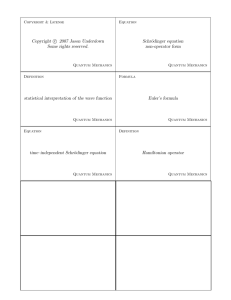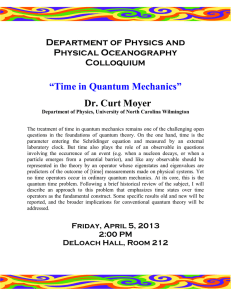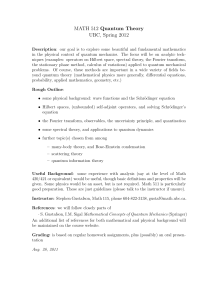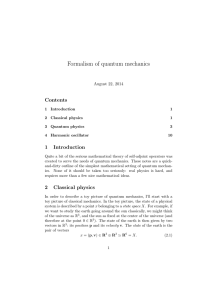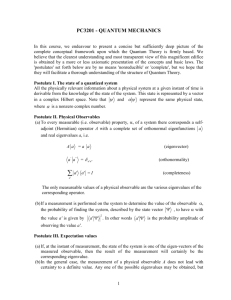of quantum mechanics Formalism Contents
advertisement
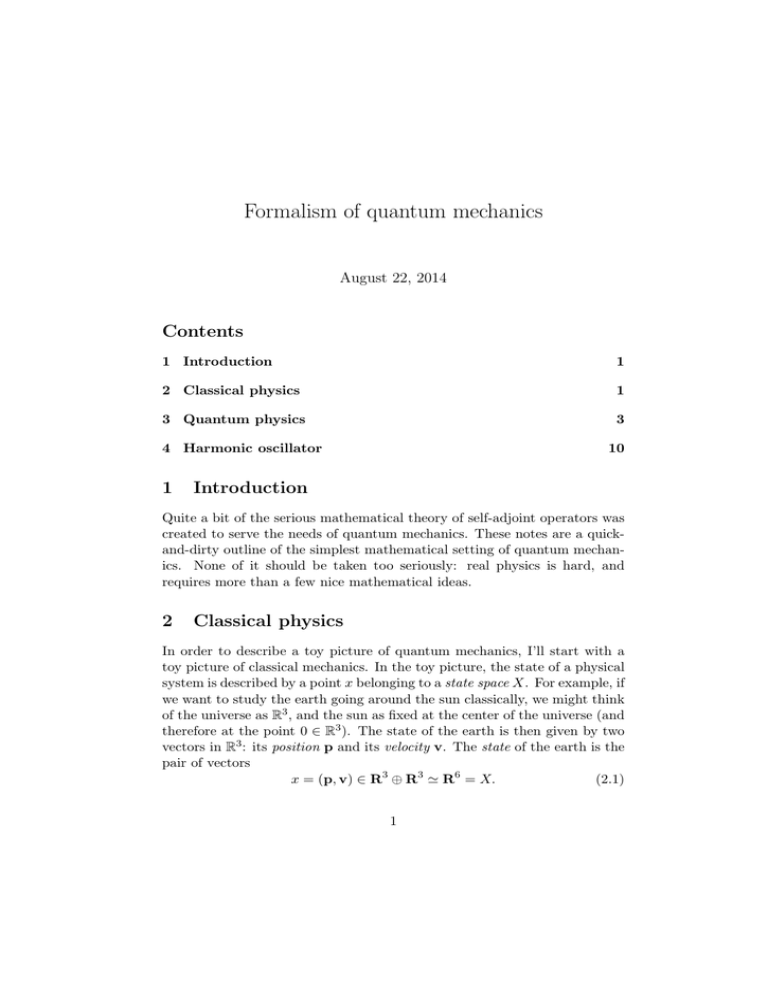
Formalism of quantum mechanics
August 22, 2014
Contents
1 Introduction
1
2 Classical physics
1
3 Quantum physics
3
4 Harmonic oscillator
1
10
Introduction
Quite a bit of the serious mathematical theory of self-adjoint operators was
created to serve the needs of quantum mechanics. These notes are a quick­
and-dirty outline of the simplest mathematical setting of quantum mechan­
ics. None of it should be taken too seriously: real physics is hard, and
requires more than a few nice mathematical ideas.
2
Classical physics
In order to describe a toy picture of quantum mechanics, I’ll start with a
toy picture of classical mechanics. In the toy picture, the state of a physical
system is described by a point x belonging to a state space X. For example, if
we want to study the earth going around the sun classically, we might think
of the universe as R3 , and the sun as fixed at the center of the universe (and
therefore at the point 0 ∈ R3 ). The state of the earth is then given by two
vectors in R3 : its position p and its velocity v. The state of the earth is the
pair of vectors
x = (p, v) ∈ R3 ⊕ R3 R6 = X.
(2.1)
1
Everything we want to know about the earth (assuming we take a sufficiently
superior attitude toward television and so on) is recorded in the pair of
vectors (p, v) ∈ R6 .
Of course the state of the earth changes with time: it moves, with a
changing velocity. What we are really interested in is the entire history of
the earth, which is a function assigning to each time t ∈ R a state x(t). For
example, if we choose coordinates so that the earth’s orbit is in the plane
of the first two coordinates, and take the orbit to be a perfect circle, the
function describing the earth now is something like
x(t) = ((R cos(φ + 2πt/T ), R sin(φ + 2πt/R, 0),
(−(2πR/T ) sin(φ + 2πt/T ), (2πR/T ) cos(φ + 2πt/T ), 0).
(2.2)
Here
R = distance to the sun ≈ 1.496 × 1011 meters,
T = length of the year ≈ 3.15569 × 107 seconds,
and φ is the angular position of the earth in its orbit at time zero.
The job of classical physics is to tell you how to find the future x(t) from
knowledge of the state x(t0 ) at one time t0 . Typically the answer is in the
form of a differential equation
dx
= F (x, t),
dt
(2.3)
which says that how the state of the system changes depends on its present
state and the present time. The right side F (x, t) is a “direction” at x. If X
is inside a vector space, then F (x, t) is always a vector in that same space;
so F (x, t) is a vector field on X (maybe changing with time.) If you know
what a manifold is, and X is a manifold, then F (x, t) belongs to the tangent
space Tx (X) to X at x.
For the motion of the earth around the sun, Newton’s laws give the
differential equation as
d(p, v)
−GMs p(t)
= (v(t),
).
dt
Ip(t)I3
(The first three coordinates of the equation are just the definition of velocity.
What’s interesting is how the velocity is changing.) Here G is Newton’s
gravitational constant, and Ms is the mass of the sun. (By comparing this
equation with the formula for x(t) above, you can get a value for GMS .)
2
A nice feature of this equation is that it depends only on x(t) and not
otherwise on t: the laws of physics are not changing with time.
In addition to predicting the future, physicists like to look at things. A
classical observable is a real-valued function on the state space X:
A : X → R.
If the system is in the state x ∈ X, making the observation yields the
number A(x). The equation of motion (2.3) and the chain rule tell you how
the observable A changes as the system evolves:
dA(x(t))
= (F (∗, t) · A)(x(t)).
dt
(2.4)
The rate of change of A is gotten by taking the directional derivative of A
in the direction F (in abstract mathematical language, applying the vector
field F to A) then evaluating at x(t).
Definition 2.5. The observable A is conserved by the classical physical
system (2.3) if F (∗, t) · A = 0; that is, if A is constant in the directions of
the vector fields F (∗, t). In this case, the value of A is constant in t for any
possible history x(t).
For the motion of the earth around the sun, a typical observable is the
distance to the sun:
d(p, v) = IpI.
Even though this observable happens to be constant in the circular orbit
solution (2.2), it is not conserved: there are other possible histories (like
elliptical orbits) in which it is not constant.
3
Quantum physics
So here is the corresponding toy picture of quantum mechanics. The under­
lying mathematical structure of a state space X is replaced by a complex
inner product space, often denoted H. (This is what we have called V in
class.) A state of the physical system is a line (a one-dimensional complex
subspace) of H. Another way to say this is that a state is a nonzero vector
ψ ∈ H, and that ψ and zψ define the same state whenever z is a nonzero
complex number. (The vector ψ is just like the vectors we’ve been calling
v; I switched to the Greek letter only to follow common physics notation.)
A lot of sources say that a state is a vector ψ with IψI = 1 (called a
unit vector) and that the unit vectors ψ and eiθ ψ define the same state. (In
3
the Copenhagen Interpretation of quantum mechanics, this corresponds to
the idea that no experiment can be designed that will distinguish between
the state ψ and the state eiθ ψ.)
I’ll stick with the idea that a state is a line Cψ, and that the chosen
basis vector ψ for the line need not be a unit vector.
Just as in classical mechanics, the state of the system changes in time. In
general, this evolution is not described as a changing line, but as a changing
basis vector for the line. That is, there is supposed to be a function
ψ : R → H − 0,
C · ψ(t) = state at time t.
(3.1)
The laws of physics are supposed to be summarized by a self-adjoint operator
H ∗ = H,
H ∈ L(H),
(3.2)
called the Hamiltonian of the physical system. I’ll say more in a moment
about the physical interpretation of this linear transformation. The first
point is that the quantum-mechanical version of (2.3) is the Schrödinger
equation
dψ(t)
1
= Hψ(t).
(3.3)
dt
i�
The first big difference from (2.3) is that the Schrödinger equation is required
to be linear. This seems to make quantum mechanics simpler than classical
mechanics. One reason that quantum mechanics can stay frightening is that
the vector space H is most often infinite-dimensional.
Suppose ψ(t) is a solution of the Schrödinger equation. Let us see how
the length of the vector ψ(t) ∈ H changes in time. We calculate
d(ψ(t), ψ(t))
=
dt
=
=
=
dψ(t)
, ψ(t) +
dt
1
Hψ(t), ψ(t)
i�
1
Hψ(t), ψ(t)
i�
1
Hψ(t), ψ(t)
i�
dψ(t)
dt
1
+ ψ(t), Hψ(t)
i�
1
−
ψ(t), Hψ(t)
i�
1
−
Hψ(t), ψ(t)
i�
ψ(t),
(product rule)
(Schrödinger)
(Hermitian)
(selfadjoint)
= 0.
(3.4)
Therefore
a solution ψ(t) to Schrödinger’s equation (3.3) has constant length. (3.5)
4
A quantum observable is a self-adjoint linear transformation on
A∗ = A.
A ∈ L(H),
(3.6a)
If H is finite-dimensional, then the spectral theorem says
H=
Hλ ,
(3.6b)
λ∈R
with Hλ the λ-eigenspace of the observable A. (If H is infinite-dimensional,
there are still versions of the spectral theorem available. The number of
eigenvalues may be infinite, and proving the spectral theorem requires more
work; but the finite-dimensional case still gives a reasonable picture of what
is going on.)
The possible values of the observable A are the real numbers that are
eigenvalues of A. If a state Cψ is contained in the eigenspace Hλ , then we
say that the value of the observable is λ.
The central idea of quantum mechanics is this: most vectors in H (and
therefore most states of the corresponding physical system) do not belong to
any one eigenspace. Instead the vectors (and so the states) are linear com­
binations (the physics word is superpositions) of many eigenvectors. What
this means is that the observable is simultaneously taking on many different
values. This isn’t how classical observables work, but quantum mechanics
is just different.
To be more concrete, suppose that the observable A has the spectral
decomposition written in (3.6b). If Cψ is a state, then the eigenspace de­
composition of ψ is
ψ=
ψλ ,
Aψλ = λψλ .
(3.6c)
λ∈R
Because the decomposition is orthogonal, the Pythagorean Theorem says
(ψλ , ψλ ),
(ψ, ψ) =
(3.6d)
λ∈R
or equivalently
1=
λ∈R
(ψλ , ψλ )
.
(ψ, ψ)
(3.6e)
On the right we have a bunch of nonnegative numbers adding up to one.
Whenever you see such a thing, you should think probability. In this case,
one of the standard ways of thinking about quantum mechanics is
(ψλ , ψλ )
= probability that observable A has value λ.
(ψ, ψ)
5
(3.6f)
The Copenhagen Interpretation raises this idea a bit higher: it says that if
the quantum system is in the state Cψ, and you perform an experiment to
measure the observable A, then the probability that you will measure λ is
λ ,ψλ )
equal to (ψ(ψ,ψ)
. Quantum mechanics doesn’t tell you what will happen: it
offers a library of possible outcomes (the eigenvalues of A) and tells you the
probability of seeing each of them.
One of the basic ideas in probability is the idea of expected value. This
is the average of all possible outcomes of some trial, with the outcomes
weighted by their probability. If I have five test papers in a hat, with the
scores 58, 63, 79, 87, and 98, and I draw one paper at random from the hat,
then the expected value of the score is
1
1
1
1
1
· 58 + · 63 + · 79 + · 87 + · 98 = 77,
5
5
5
5
5
the ordinary average of the scores. If I roll a fair die, the expected number
appearing is
1
1
1
1
1
1
· 1 + · 2 + · 3 + · 4 + · 5 + · 6 = 3.5.
6
6
6
6
6
6
(Notice that this “expected value” cannot actually occur.)
In the Copenhagen Interpretation, the expected value of the experiment
to measure the value of the observable A is
X (ψλ , ψλ )
·λ
(weighted average of outcomes)
E(A) =
(ψ, ψ)
λ∈R
=
X (λψλ , ψλ )
(ψ, ψ)
λ∈R
=
X (λψλ , ψ)
(ψ, ψ)
(orthogonality of eigenspaces)
(3.6g)
λ∈R
=
(
λ∈R λψλ , ψ)
(ψ, ψ)
( λ∈R Aψλ , ψ)
=
(ψ, ψ)
(Aψ, ψ)
E(A) =
.
(ψ, ψ)
(linearity of inner product)
This expected value varies continuously with the quantum state, from a
maximum of the largest eigenvalue of A (if the state belongs to the corre­
sponding eigenspace) to a minimum of the smallest eigenvalue of A.
6
It’s natural to try to concentrate on observables that you can reliably
observe; that is, to look only at states ψ ∈ Hλ that are eigenvalues for A. The
essential difficulties of quantum mechanics arise when you are interested in
two different observables A and A' , so that there are two different eigenspace
decompositions
M
M
H=
Hλ' ,A' .
(3.6h)
H=
Hλ,A ,
λ' ∈R
λ∈R
In this situation you might like to concentrate on states in which you can
reliably observe both A and A' ; that is, states that are in a “simultaneous
eigenspace”
(3.6i)
H(λ,λ' ) = Hλ,A ∩ Hλ' ,A' .
The difficulty is that all these spaces can be zero: there may be no simul­
taneous eigenspaces of A and A' . This is not something pathological, but
rather entirely typical.
Example 3.7. Suppose H = C2 , so that self-adjoint operators are 2 × 2
matrices
a z
(a ∈ R, z ∈ C).
z b
Two natural observables are
A=
1 0
,
0 −1
A' =
0 1
.
1 0
Each of these observables has eigenvalues +1 and −1; each can take just
those two values “classically.” (In honest physics, observables like this arise
for example in describing the polarization of light.) The spectral decompo­
sitions are
H = H1,A
⊕ H−1,A
=C
1
0
⊕C
H = H1,A'
=C
0
.
1
⊕ H−1,A'
1
1
⊕C
1
.
−1
The eigenspaces for A are the two coordinate axes; and the eigenspaces for A'
are the two diagonal lines. There are no simultaneous eigenvectors except 0,
which does not represent a state (since a quantum state is a one-dimensional
subspace).
7
Problem set 9 says that if the observables A and A' commute, then there
is a simultaneous eigenspace decomposition. (It’s easy to see that commuting
is a necessary condition for the simultaneous eigenspace decomposition: do
you see why?) So quantum-mechanical difficulties are attached to observables
that do not commute. Example 3.7 says that this is mathematically very
common. One of the fundamental physical principles of quantum mechanics
is that the observables position and momentum never commute. That is,
the most basic physical observables—position and velocity—can never be
reliably observed at the same time. That’s what the Heisenberg uncertainty
principle is about. Some details may be found in Section 4 (see (4.5b)).
The Hamiltonian H appearing in the Schrödinger equation (3.3) is a
self-adjoint operator, so it is also an observable. It’s the most important
observable of all: the energy of the physical system. The eigenvalues of H
are the possible energies that the system can have. If ψ0 ∈ HE is in the
E-eigenspace—that is, if ψ0 has energy equal to E—then Hψ0 = Eψ0 , and
we get an easy solution to the Schrödinger equation:
ψ(t) = eEt/i~� ψ0 .
(3.8)
That is, a state purely in the energy level E does not change; only its phase
oscillates, with a frequency of
� = E/h.
ν = 2πE/~
(3.9)
This is Planck’s relation between frequency and energy: originally found for
photons, but now making some kind of sense for any quantum-mechanical
system.
Definition 3.10. The observable A is conserved by the quantum physical
system (3.3) if the expected value of the observable
(Aψ(t), ψ(t))
(ψ(t), ψ(t)
is constant in time.
Proposition 3.11. Suppose
ψ: R → H
is a solution of the Schrödinger equation (3.3), and that A ∈ L(H) is an
observable. Then the expected value of A
E(A)(t) =
(Aψ(t), ψ(t))
(ψ(t), ψ(t))
8
satisfies the differential equation
dE(A)
1
= E( (AH − HA)).
dt
i~
�
Here i1�~ (AH − HA) ∈ L(H) is a self-adjoint linear transformation (and so
a new observable).
In particular, A is conserved if and only if AH = HA; that is, if and
only if the linear maps A and H commute with each other.
To a mathematician, the proposition above suggests that one should
replace each physical observable
A = selfadjoint operator
(A∗ = A)
(3.12a)
(S ∗ = −S),
(3.12b)
by a “mathematical observable”
SA = skew-adjoint operator
according to the rule
SA =
1
A,
�
i~
A = i�
~S.
(3.12c)
Given two mathematical observables S and S ' , one can form a new mathe­
matical observable
(3.12d)
[S, S ' ] = SS ' − S ' S,
called the commutator of S and S ' . This operation, called commutator or
Lie bracket makes the mathematical observables into a Lie algebra. The
Schrödinger equation takes the form
dψ(t)
= SH ψ(t).
dt
(3.12e)
The differential equation in the proposition above is
dE(A)
= E(i~
�[SA , SH ]).
dt
(3.12f)
So the commutator describes exactly the how observables change in time.
9
4
Harmonic oscillator
This possible future section will write down the classical and quantum mod­
els for a one-dimensional harmonic oscillator, and compare their solutions.
For now I’ll just write a little. The inner product space is
∞
H = L2 (R) = {ψ : R → C |
|ψ(x)|2 dx < ∞}.
(4.1)
−∞
We’ll be vague about exactly which functions ψ are allowed; this is one of
the places where the details are difficult.
The inner product is like the one used on functions on [0, 1] in the text
and problem sets:
∞
(ψ1 , ψ2 ) =
ψ1 (x)ψ2 (x) dx.
(4.2)
−∞
Recall that a state corresponds to a line Cψ ⊂ H. We think of it as corre­
sponding to a (quantum) particle living at some indeterminate place on the
real line; the size |ψ(x)|2 of the function represents the probability that the
particle is at x. (A little more precisely, the integral
1
(ψ, ψ)
b
|ψ(x)|2 dx
a
is the probability that the particle is between a and b.)
The classical observable position corresponds to the (selfadjoint) quan­
tum observable
(M ψ)(x) = xψ(x).
(4.3a)
That is, we multiply the function ψ by the function x. (The letter M is
chosen to be a reminder of “multiply.” The eigenspace for a real number λ
is
Hλ,M = Hλ = {ψ | xψ(x) = λψ(x)}
(4.3b)
= {ψ | ψ(x' ) = 0, x' = λ}.
That is, the eigenspace consists of multiples of the Dirac delta “function”
�
∞ x = λ,
δλ ,
δλ (x) =
(4.3c)
0
x = λ.
The “function” δλ is not in L2 (R), because it is too concentrated at the point
λ. (I can’t make this precise, because I haven’t said exactly what functions
are allowed in L2 (R). The idea is that a nice function on the real line that is
10
zero except at one point must be zero everywhere.) Nevertheless, one should
think of every real number λ as an eigenvalue of M , with eigenvector δλ .
Even though it is not an actual function, certain integrals involving δλ
make sense. What is required (and what becomes the mathematical defini­
tion of δλ ) is that for any nice function φ,
Z ∞
φ(x)δλ (x) dx = φ(λ)
(4.3d)
−∞
Using the formal “definition” (4.3c), it is clear that
δλ (x) = δx (λ).
(4.3e)
Using the mathematical definition hinted at in (4.3d), it is possible to make
this statement meaningful and precise; but I won’t worry about it.
In the case of a self-adjoint operator A on a finite-dimensional vector
space V , we can choose a basis of eigenvectors
(eλ1 , . . . , eλn ),
Aeλi = λi eλi
P
Then any vector in v has a finite sum expansion v = i ai eλi ; the magnitude
|ai |2 tells how much of v is in the direction of the eigenvalue λi .
In this infinite-dimensional, setting, the finite sum is replaced by an
integral
Z
∞
φ=
a(λ)δλ dλ
(4.3f)
−∞
In order to see what the coefficients a(λ) of the various eigenvectors δλ should
be, first plug in x; then use the formula (4.3e); and finally use (4.3d):
Z ∞
φ(x) =
a(λ)δλ (x) dλ
−∞
Z ∞
(4.3g)
=
a(λ)δx (λ) dλ = a(x).
−∞
The conclusion is that
Z
a(x) = φ(x),
∞
φ=
φ(λ)δλ dλ.
(4.3h)
−∞
That is, the size of |φ(λ)|2 measures how much of the state φ is at the
position λ.
11
The classical observable momentum corresponds to the (selfadjoint) quan­
tum observable
dψ
(Dψ)(x) = −i~
(4.4a)
� ,
dx
a multiple of the derivative of ψ. (The letter D is chosen to be a reminder
of “derivative.” The eigenspace for a real number µ is
Hµ,D = Hµ = {ψ | Dψ(x) = µψ(x)}
= {ψ(x) = Aeiµx/~� }.
(4.4b)
That is, the µ eigenspace consists of multiples of the exponential function
eξ (x) =def e2πiξx .
eµ/h ,
(4.4c)
These exponential functions are not in L2 (R), because they are too spread
out over R: the absolute value squared is one everywhere, so cannot have
finite integral. Nevertheless, one should think of every real number µ as an
eigenvalue of D, with eigenvector eµ/h .
Just as in the case of position, we want to replace the finite sum in the
finite-dimensional spectral theorem by an integral, and write any vector φ
as an integral of eigenvectors:
Z ∞
φ=
b(µ)eµ/h dµ
(4.4d)
−∞
In order to see what the coefficients b(µ) of the various momentum eigen­
vectors eµ/h should be, first plug in x, then perform the change of variable
ξ = µ/h:
Z
∞
φ(x) =
b(µ)eµ/h dµ
−∞
Z
(4.4e)
1 ∞
b(hξ)eξ dξ
h −∞
The integral on the left is an inverse Fourier transform. Here are the
basic definitions and facts. If φ and ψ are nice complex-valued functions on
R, then the Fourier transform of φ is a new (nice) complex-valued function
on R, defined by
Z ∞
Z ∞
ˆ
ψ(ξ)
=
ψ(x)e−ξ (x) dx =
ψ(x)e−2πixξ dx.
(4.4f)
=
−∞
−∞
The inverse Fourier transform of φ is the new (nice) complex-valued function
on R defined by
Z ∞
Z ∞
ˇ
φ(x)
=
φ(ξ)ex (ξ) dξ =
φ(ξ)e2πixξ dξ.
(4.4g)
−∞
−∞
12
The main theorem (Fourier inversion) is that the Fourier transform is an
isometry (length-preserving invertible linear map) on L2 (R), with inverse
equal to the inverse Fourier transform:
(φ̂)ˇ = φ,
Iφ̂I = IφI
(φ ∈ L2 (R)).
(4.4h)
Comparing (4.4e) with (4.4g), we conclude that
Z
1 ∞ ˆ
b(µ) = φ̂(µ/h),
φ=
φ(µ/h)eµ/h dµ.
h −∞
(4.4i)
That is, the size of |φ̂(µ/h)|2 measures how much of the state φ has momen­
tum µ.
The main point of all this is that the states corresponding to a precise
position λ—the “Dirac delta functions” δλ —are completely different from
the states corresponding to a precise momentum µ—the complex exponen­
tials eµ/h . We saw in a pset that commuting selfadjoint operators could
be simultaneously diagonalized: that there would in lots of simultaneous
eigenstates, where both observables are precisely known. The position and
momentum operators P and D do not commute; in fact
dφ
d
+ i~
� (xφ)
dx
dx
dφ
dφ
�
�(x
= −ix~
+ i~
+ φ)
dx
dx
�φ.
= i~
(M D − DM )φ = −ix�
~
(4.5a)
That is,
~,
[M, D] = i�
(4.5b)
the canonical commutation relation of Heisenberg. If we use the language
of skew-adjoint “mathematical observables” discussed in (3.12), then the
skew-adjoint operators corresponding to position and momentum are
SM = x/i~
�,
SD = −
d
,
dx
[SM , SD ] =
1
.
�
i~
(4.5c)
As explained in the text, no such commutation relations can be satisfied
by operators on a finite-dimensional inner product space: the left side has
�)±1 times the
trace equal to zero, and the right side has trace equal to (i~
dimension of the space. So any quantum mechanics involving positions and
momenta has to live in an infinite-dimensional inner product space.
So you need to take more math classes after this one!
13
MIT OpenCourseWare
http://ocw.mit.edu
18.700 Linear Algebra
Fall 2013
For information about citing these materials or our Terms of Use, visit: http://ocw.mit.edu/terms.


